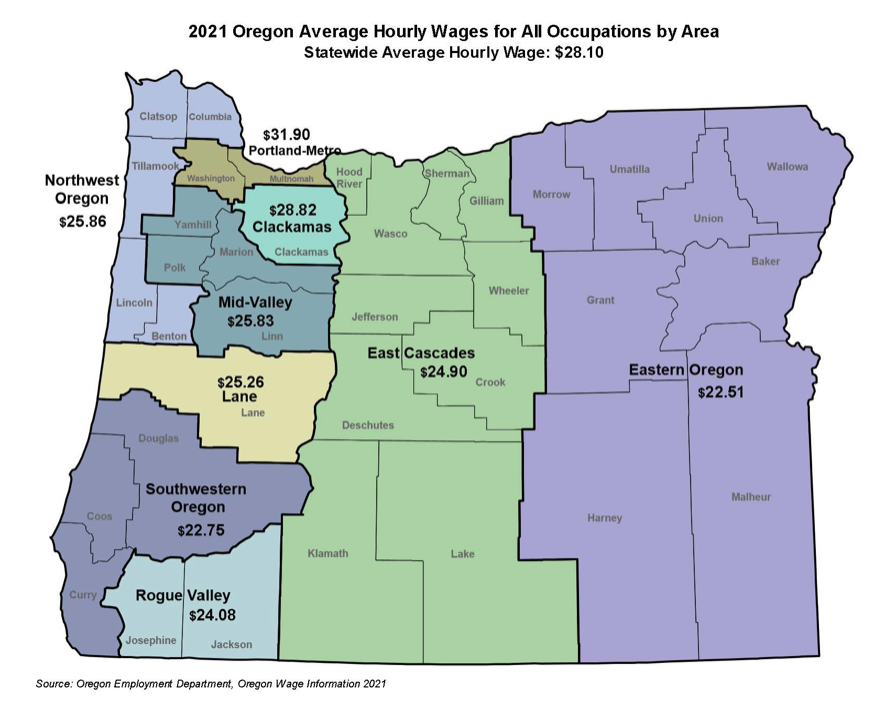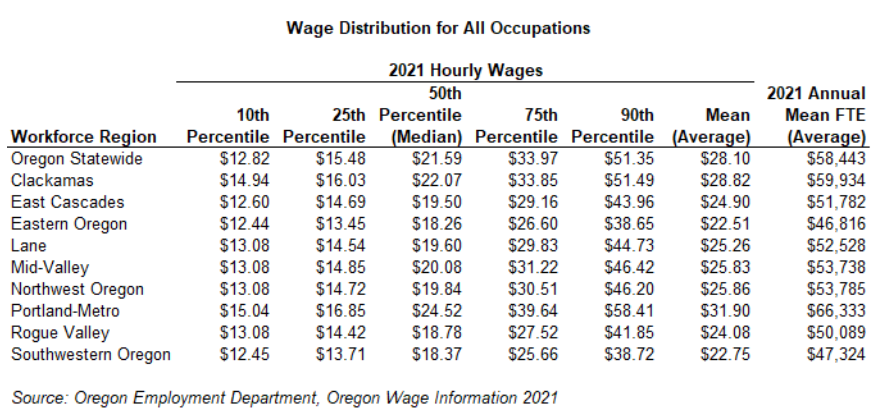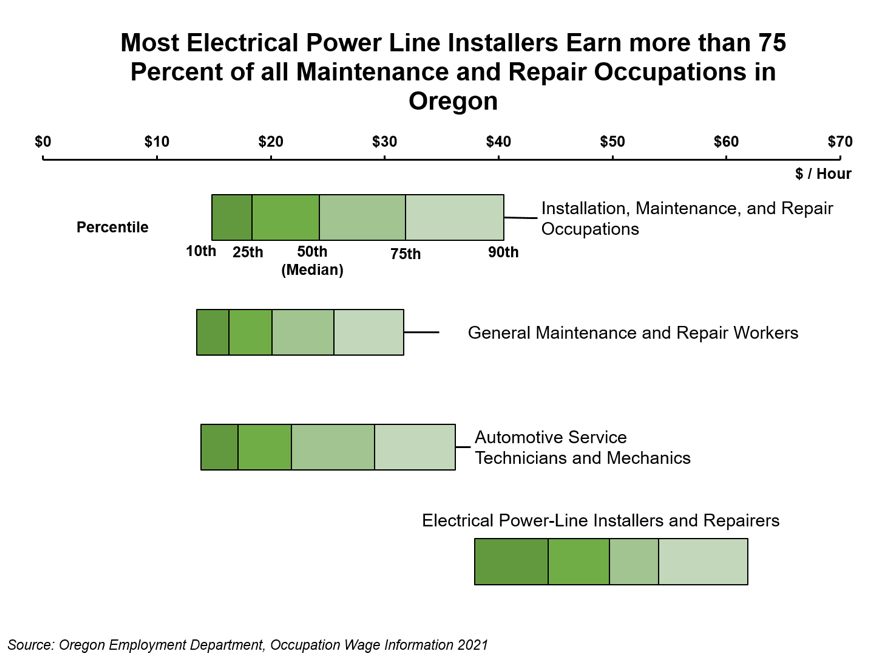2021 Oregon Wage Information
How do we know the worth of our work? How do we know we are paying employees a competitive wage? The only way to know is to get a snapshot of what other workers are getting paid for doing similar work. If you don’t know where to start, the Oregon Employment Department is here to help.

The 2021 version of the Oregon Employment Department’s Occupational Wage Information is now available. Thanks to survey responses from employers around the state, wage estimates for nearly 740 occupations have been published.
The annual average wage for all occupations in Oregon was $58,443 in 2021, or $28.10 per hour. Of the occupations with published data, gambling dealers had the lowest average wage of $13.14 per hour. Orthodontists had the highest average wage ($147.76 per hour). Dental specialists like orthodontists have such a high average wage because it take many years of education and experience in order to perform that level of work.
The cost of living, mix of industries, and available workforce can be different across the state. We may see a higher number of software engineers and folks working in corporate headquarters in Portland, while natural resource jobs may be more concentrated in rural communities, and leisure and hospitality jobs focused near the coast. Wage estimates reflect these differences. The average hourly wage for Multnomah, Washington, and Clackamas counties was $31.39 in 2021. Jobs in Eastern Oregon ($22.51) and Southwestern Oregon ($22.75) had lower average wages than jobs around the Portland tri-county area.

Wage estimates are not immune from the influences of the pandemic. We have seen shifts in employment levels and wages in different parts of the state. For instance, the average wage for Northwest Oregon ($25.86) was greater than the Mid-Valley ($25.83) for the first time since 2016. While variations from one year to another can usually be stocked up to adjustments for inflation and changes in what businesses are sampled in the survey, national data from the Bureau of Labor Statistics show that states that experienced a higher relative decline in leisure and hospitality employment saw higher than expected changes in average wage.
Prior to the pandemic Northwest Oregon had a higher share of workers employed in leisure and hospitality than the Mid-Valley area. Leisure and hospitality jobs in many cases pay a lower than average wage. If the shutdowns from the pandemic adversely affected jobs on the lower end of the pay scale, then the average wage for the jobs that remain in the area will increase because those lower-paying jobs are not counted. That may be what we are seeing in Northwest Oregon, and generally across the country. We will have to watch wage estimates for the next couple of years to see if average wages in Mid-Valley move ahead of Northwest Oregon as leisure and hospitality employment recovers.
Looking at average wages is like looking at a car without seeing what is under the hood. You can get a sense for the style and make of the vehicle, but you are missing the complex mechanics that make the wheels turn. We need to look at the wage ranges of different occupations to see how pay for one career aligns with another.
Wage ranges give us a better idea of what we could expect if we were to hire, or work in a particular occupation. We provide wage ranges by publishing a series of percentiles for each occupation. A percentile wage shows the percentage of workers in an occupation that earn less than a given wage and the percentage that earn more. In most cases, wages in the 10th or 25th percentile likely reflect workers just entering a career, or who have less education attainment than others performing similar work. To better calibrate our understanding of wage ranges let’s look at the wages for maintenance and repair occupations in Oregon.
Most maintenance jobs in Oregon pay between $14.84 and $40.45 per hour. More than 30% of these jobs in Oregon are either general maintenance workers or automotive service technicians. Wages for the two occupations are very close to the state median wage. The wage ranges between entry-level workers and experienced employees is similar to the wage range for all maintenance and repair jobs. Other maintenance occupations that require more experience or licensing can pay significantly more.

For instance, electrical power line installers and maintenance workers install or repair cables or wires used in electrical power or distribution systems. These are some of the highest paying maintenance jobs in Oregon. The pay premium comes from having to work in difficult or hazardous conditions. Many power line installer job openings require the completion of an apprenticeship, as well as obtaining licensing such as a commercial driver’s license. The wage range estimates show that essentially all power line workers earn a higher wage than 75% of all maintenance and repair jobs.
Occupational wage information allows us to better understand what people get paid for the work they do, and how that may differ across the state. To get additional wage estimates for hundreds of careers please visit QualityInfo.org.
By Jason Payton Occupational Economist jason.m.payton@oregon.gov Original posted at https://www.qualityinfo.org/-/2021-oregon-wage-information


Advertisement